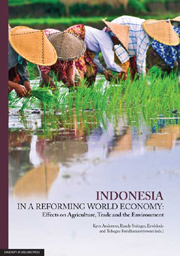Book contents
- Frontmatter
- Contents
- List of tables, figures and boxes
- FIGURES
- Acronyms
- Preface
- List of contributors
- 1 Introduction
- 2 Effects of growth, its interruption, and the Uruguay Round on Indonesian agriculture
- 3 Effects of AFTA and APEC trade policy reforms on Indonesian agriculture
- 4 Trade liberalisation and soil degradation in Indonesia
- 5 Will the Uruguay Round and APEC reforms harm air and water quality in Indonesia?
- 6 Impacts of agricultural protection growth at home and the WTO's Doha Round on Indonesian agriculture
- 7 Effects of agricultural policy reform on household and regional income distribution in Indonesia
- 8 Effects of farm policy reform on Indonesia's secondary food crops
- 9 Effects of agricultural policy reform in Indonesia on its food security and environment
- 10 Impacts of trade policy reform on income distribution and poverty in Indonesia
- APPENDIX 1 The WAYANG Model of the Indonesian economy
- APPENDIX 2 The GTAP Model and database
APPENDIX 2 - The GTAP Model and database
Published online by Cambridge University Press: 05 June 2012
- Frontmatter
- Contents
- List of tables, figures and boxes
- FIGURES
- Acronyms
- Preface
- List of contributors
- 1 Introduction
- 2 Effects of growth, its interruption, and the Uruguay Round on Indonesian agriculture
- 3 Effects of AFTA and APEC trade policy reforms on Indonesian agriculture
- 4 Trade liberalisation and soil degradation in Indonesia
- 5 Will the Uruguay Round and APEC reforms harm air and water quality in Indonesia?
- 6 Impacts of agricultural protection growth at home and the WTO's Doha Round on Indonesian agriculture
- 7 Effects of agricultural policy reform on household and regional income distribution in Indonesia
- 8 Effects of farm policy reform on Indonesia's secondary food crops
- 9 Effects of agricultural policy reform in Indonesia on its food security and environment
- 10 Impacts of trade policy reform on income distribution and poverty in Indonesia
- APPENDIX 1 The WAYANG Model of the Indonesian economy
- APPENDIX 2 The GTAP Model and database
Summary
Introduction
The Global Trade Analysis Project (GTAP) model is a global computable general equilibrium (CGE) model which has its origins in the SALTER model (Jomini et al. 1991). Since its inception in 1993, GTAP has become widely used and respected by researchers and policy-makers around the world.
In this Appendix we introduce some of the key features of the GTAP database and model, applications of which are used in a number of chapters in this book. We then explain how results from the GTAP model can be analysed and we conclude with a summary of some of the main advantages and limitations of global CGE analysis.
The GTAP database
The GTAP model and database are publicly available and fully documented; these features enhance the credibility of modelling work and facilitate comparability of analysis. The global database is updated approximately every eighteen months, with contributions coming from throughout the GTAP network of international organisations and country experts. Version 3 of the database comprises 37 commodities and 30 countries (McDougall 1997), while Version 4 of the database comprises 50 commodities and 45 regions (McDougall et al. 1998). In both versions, Indonesia is one of the countries specified and there is a relatively heavy disaggregation for agricultural sectors. Table A1 details the countries and regions in recent versions of the GTAP database, while Table A2 shows the commodity breakdown. To aid computation and to highlight the implications for the regions and sectors of particular interest, the GTAP database is generally aggregated to a smaller number of regions and sectors when running simulations and interpreting results.
- Type
- Chapter
- Information
- Indonesia in a Reforming World EconomyEffects on Agriculture, Trade and the Environment, pp. 255 - 265Publisher: The University of Adelaide PressPrint publication year: 2009



